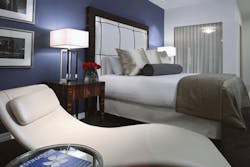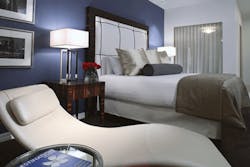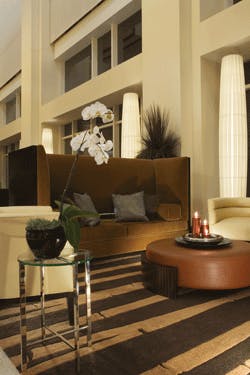The Inside Story on Hospitality Facilities
By Maureen Orsborn
In today's hospitality industry, attention to detail determines distinction. "Lots of people are trying to strengthen their brand identity by making their product a little more unique," says Ron Crawford, senior associate at Atlanta-based Thompson, Ventulett, Stainback & Associates. "There have been several new brands to come onto the market lately, so there's a stronger need for that these days," he says.
From floorcoverings to furniture in the most upscale properties (and even in some budget-conscious lines), you will find a higher quality of design. "Every brand has its own profile that it's seeking and marketing," explains Stephen Yas, president at Evanston, IL-based YAS Architecture. "You're carefully having your hand on a volume control, and you're turning up the volume or turning down the volume effectively based upon response to the marketplace." He lists modern design, smart thinking, clever use of space, and upscale amenities as values of the modern traveler. Hotel professionals have taken notice, creating hospitality environments that offer a personalized experience for each guest.
Public Spaces
Crawford states that hotel lobbies are moving toward a living-room experience. "You can work there, you can meet people there, you can relax there, and you can feel comfortable there." Hotel designers plan lobby spaces that are more intimate and versatile because people do not work or meet with as much formality as they have in the past.
Yas strongly emphasizes that the objective of hotels should be to offer an environment where the guest can feel in control of his or her experience. In both the lobby and the guestrooms, movable furniture gives visitors the opportunity to arrange a comfortable setting for work or conversation, further enhancing the sense that they are receiving a customized hotel experience.
Internet technology has become an integral aspect of hotel design. People frequently travel with their laptops and want easy access to the Internet to work or keep in touch with those at home. Hotels may offer technology outlets in the café or lobby, or the whole building may be wireless. "It's really a change in how people work now," Crawford continues. "People are carrying their laptops; they want to be able to sit down in the lobby and have their wireless connection, and be able to do a little bit of work while they're waiting for someone."
A current design trend in hotel lobbies is to open up the floorplan, creating a strong visual connection from the registration desk to the sitting area, the café, and beyond. This encourages guests to move freely and creates the perception that the lobby is larger than it really is. Without impacting the budget, lobby sizes may be scaled down and customized with more high-quality interior design elements.
Private Quarters
The movement toward a more residential feel is as important in the guestroom as it is in the lobby. Many hotel brands claim that they have always tried to create a residential atmosphere, but Yas points out that many people who stay in hotels are looking for an experience that is even better than home. To provide this experience to guests, the built-ins (i.e. countertops, bathroom fixtures, doors, door handles, and woodwork) and furniture can be a unique mix of design elements made of high-quality, long-lasting materials to make guest space feel nicer and look a little different than any room the guest has stayed in before. Special consideration should also be given to the lighting in the room. The trend is to install brighter, more-efficient lighting fixtures in the bathroom as well as more sources of direct and indirect accent lighting throughout the rest of the room.
To further customize the guestroom, facilities professionals are rethinking the use of space. "There's been a trend lately of trying to break out of the technical layout with the enclosed bathroom right by the door. A lot of different brands and operators are [trying] to think of ways to reconfigure the room," says Crawford.
One very common option is to open up the bathtub or sink area to the rest of the room. Eliminating this solid wall instantly adds more diagonal space and creates the perception of a larger room. The trend of connecting the bathroom with the rest of the space is due, in large part, to the prevalence of business travelers. Since they are more likely to be staying alone in a room, they require less privacy. A second option, also tailored to the business traveler's needs, is to replace the bathtub with a shower stall. This frees up space for a larger bathroom.
Smart use of space involves allowing versatility without necessarily adding square footage. "The flat-screen TV could be on a swivel so that you can turn it to view from any vantage point in the room," Yas explains. Providing modular furniture designed for multi-tasking further allows the guest to personalize his or her stay. "When you design a very clean, smart space," Yas states, "that encourages the guest's productivity in the sense of being in control."
A Natural Trend
Going green has as much to do with building an environmentally friendly hotel as it does with incorporating nature into interior design. "I'm finding that more hotels are starting to lean toward the modern, contemporary environment by bringing in the ideas of sustainable energy and much more refined detailing," states Yas. Crawford agrees: "We're seeing a lot more of a desire for natural light, stronger views to the exterior, and better connections to the outdoors. I think a lot of that comes from increased environmental awareness."
For example, larger windows allow more sunlight into the building and provide an expansive view to the outdoors, creating the perception of a more open space. Light shelves (white surfaces that reflect available light onto the ceiling and back into the room, generating more ambient light than a single lamp) also provide more indirect lighting.
There is an increased focus on the environmental quality of products that go into a building. Yas observes that many manufacturers emphasize the sustainable production methods and materials used in their products. He notes that earth tones and more-subdued coloring are popular design trends that add a greener, "Zen-like" feel to interior spaces.
Both Yas and Crawford indicated that, in most facilities management teams, there is a sense of responsibility about recommending building materials and systems that will be sustainable over time. A hotel may incorporate green design with the intention of seeking a good LEED rating or with the objective of cutting long-term energy costs, but the overall result will be the same: A reduction in the negative impact the building will have on the environment. For years, the building industry has acknowledged that going green is the right thing to do. The public is also becoming more aware of that fact in response to recent spikes in energy prices. As a result, environmental friendliness can be a market strength for a hotel brand and lead to a better reputation among consumers.
Behind the Scenes
While guests are enjoying the amenities of the hotel, the staff is working hard to ensure that he/she has a safe and comfortable stay. Dina Zemke, professor of hospitality facilities and operations at Cornell University School of Hotel Administration in Ithaca, NY, shares how new technology has changed the hotel industry from a facilities management perspective.
Identifying capital improvements and budgeting for operating expenses in the hotel industry are a big part of facilities management's responsibility, Zemke explains. The department typically keeps track of expenses and recommends system upgrades to general and asset managers. "Sometimes, it's hard to get an entire industry to adopt new technology," she explains. "A lot of the decisions on spending are made at the property level, and the property has to balance its investments in the building with investments in cosmetics for the guest."
Zemke highlights some new energy-saving systems that are appearing more frequently in hotels. A recent trend, she explains, is to connect thermostats in guestrooms to the property management system (which maintains data related to customer reservations, check-ins, check-outs, and housekeeping). When a guest checks out, the system automatically sets the room's thermostat to "standby." Occupancy sensors, more often seen in commercial buildings, have also been installed in some guestrooms. With the installation of either of these devices, the unnecessary expense and waste caused by heating, cooling, or lighting a vacant room are reduced.
Hotels have many opportunities to cut back on water waste. Sink-faucet aerators and low-flow showerheads and toilets have long been the norm in guestrooms, but a newer trend is for hotels to reduce waste by changing their laundry methods. One approach has been to let guests display a card indicating that housekeeping does not need to change the linens daily. Another option for hotels with on-premises laundry is an ozone-based system. Germ-killing ozone (a gas that disinfects linens and gets rid of grease stains) is injected into the water as towels and linens are washed, cutting back on water, heating, and chemical usage. The ozone turns back into oxygen in the process. Zemke explains that these systems can reduce costs for many hotels with on-site laundry. She notes that ozone systems are expensive, but considering the payback period, their present value is "very, very favorable."
So, do hotels need to hire an engineering staff with more specialized training to service all of this new technology? It depends on the building. "As you get into really large properties, you have a very well-trained, professional staff," Zemke says. Larger properties that are heated and cooled by centralized boilers or refrigeration systems are often required by law to have someone with a boiler operator's or refrigeration license on-site 24/7. A larger property's facilities management team may include electrical and plumbing specialists. Smaller properties that heat and cool rooms with PTAC units may retain staff members that are generalists while keeping specialists on call. With respect to wireless systems, the front of the house may have a tech specialist that can troubleshoot small problems. When more complex problems with the system arise, a contractor must usually be called in.
Facilities management should perform routine preventive maintenance on cosmetic aspects of the building, as well as on fire and safety systems - having to call the front desk because something does not work takes away from the guest's sense of safety and control over his or her environment.
Drawing on her experience in the industry, Zemke states that, from her perspective, a guest has a good experience when he doesn't see the team in action. "You only notice [something] when it's a problem so if there were no problems, it was a good stay - at least from our end!"
Maureen Orsborn is a contributing editor at Buildings magazine.


